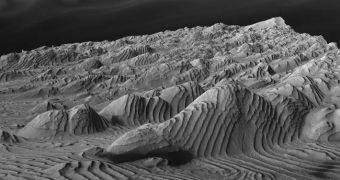Scientists from the California Institute of Technology (Caltech) have been using images provided by the High Resolution Imaging Science Experiment (HiRISE) camera of NASA's Mars Reconnaissance Orbiter probe in order to determine whether there are any distinguishable patterns in the Martian rocks. The photographs of four craters inside Mars' Arabia Terra region indicated that there are indeed such patterns, and the scientists linked those to the changes in the planet's axial tilt.
The axis is an imaginary straight line that links a planet's poles; in many cases, it is oblique or tilted. During the spinning process, the tilt's degree varies along cycles of different lengths. In the Earth's case, this cycle lasts for about 41,000 years and sees the axis wobbling along a range of 2.4 degrees, between 22.1 and 24.5 degrees, causing millennia-long events like ice ages. This is more obvious for Mars, whose tilt wobbles along tens of degrees during a 100,000 year cycle.
The layers of sedimentary rocks in Mars' Becquerel crater sported patterns that suggest they were formed every 100,000 years due to repeated changes in the planet's climate. "Due to the scale of the layers, small variations in Mars's orbit are the best candidate for the implied climate changes," shared Caltech's graduate student Kevin Lewis, the leader of the study, cited by Space. "These are the very same changes that have been shown to set the pacing of ice ages on the Earth and can also lead to cyclic layering of sediments."
At low Martian obliquity (axis tilt), the planetary poles were extremely cold (due to their increased distance from the Sun), that affected the atmosphere and, in turn, the way material was sedimented. Atmospheric CO2 and water shifted towards the poles, and were trapped there as ice. An increased obliquity brings about the reversing of the process, with CO2 and water migrating away from the poles. "If you move carbon dioxide away from the poles, the atmospheric pressure would increase, which may cause a difference in the ability of winds to transport and deposit sand," explained another Caltech team member, Oded Aharonson.
Even more, the team found that every ten layers were grouped together in larger patterns, formed every one million years (ten of such large patterns appeared repeatedly in the Becquerel crater). The larger patterns are thought to be caused by a known phenomenon determined by the impact of the dynamics of the solar system that changes Mars' obliquity. "This study gives us a hint of how the ancient climate of Mars operated, and shows a much more predictable and regular environment than you would guess from other geologic features that indicate catastrophic floods, volcanic eruptions and impact events," added Lewis.

 14 DAY TRIAL //
14 DAY TRIAL //